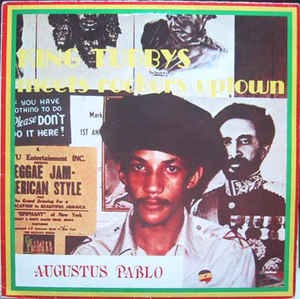I'm in the Mood for Dub
Image: Album cover for 'Scientific Dub' by Scientist.
Like many white kids of my vintage, I started getting turned on to reggae from original UK punk bands like The Slits, The Ruts and especially The Clash. Strummer and co. often flirted with roots reggae, but delivered it through their own identity with BPMs bumped up, while guitars and drums slashed and bashed. It’s no wonder The Clash were seeped in the sound; their earliest shows in 1976 at the famous UK punk club The Roxy also featured dreadlocked DJ, and later acclaimed documentarian, who spun a reggae-only set in between the punk bands of the day. London had been seeped in the Caribbean sounds since sounds of ska and rocksteady started spilling onto the dance floor in the mid sixties. It was these Caribbean sounds that had people of all races skanking on the dance floor, as different cultures met under the same council estate roofs.
The Clash turned my head with reggae-influenced songs like '(White Man) In Hammersmith Palais' and 'The Guns of Brixton.' I was similarly caught as well by Toots & The Maytal's classic 'Pressure Drop,' as well as Junior 'Police and Thieves,' produced by Lee “Scratch” Perry (who will feature later in this article). But it was when The Clash gave up their reigns on side two of their EP 'Black Market Clash' to Mickey Dread that I really first heard dub. Shorty afterwards, I immersed myself in Pubic Image’s 'Metal Box,' digging into its deep bass driven by Jah Wobble, as John Lydon toasts over top. After hearing Bauhaus’ mesmerizing 'Bela Lugosi’s Dead,' I began my search for the Jamaican records that heavily influenced these tracks.
Dub music comes from the reggae sound systems that could be found all over Jamaica of the early sixties and seventies. These sound systems were cobbled-together amplifiers that would power a wall of subs, mid-frequency speakers and horns, that would blare the latest reggae tracks all over the island until the light finally spilled out. The owners of these sound systems were very competitive, and often DJs (know as 'selectors') would play records with no labels to hide their identities, and would with other sound systems in competition for the dancing masses. Records known as 'dub plates' of popular songs of the day were stamped in extremely limited runs, so that a DJ or toaster could rap over the 'riddim' without the original vocals appearing in the mix. Once engineers started adding effects to the backing tracks, like delay, high pass filter, extreme reverb and found sounds, dub really began to take off. Singles were released in accordance with the reaction garnered from crowds at the sound system dances. The B-side was pressed with the vocals muted and effects added, and was called a 'version'. By the early to mid seventies, these versions became more popular than their A-side counterpart.
The dub pioneers who turning the tiny island on its ear would include Osbourne “King Tubby” Ruddock, Lee “Scratch” Perry, Herman Chin Loy, and others who proved the mixing board itself could just as valid of a musical instrument as anything else. With psychedelic effects bending time and perception while soaring in the front of the mix, this new dub sound seemed like the perfect soundtrack for ganja-smoking Rastafarians who came down from the hills into Kingston.
Whenever post-punk, post -rock, electronic, dubstep, and other similar genres flip the script and shoot for otherworldly destinations, you can directly attribute the influence back to dub and the records and sound systems which took over Jamaica during the brief years of 1974 to 1983. Although my dub odyssey has been incredibly rich and rewarding and has taken up quite a lot of real estate on my vinyl shelves I would say these five dub classics that raged out of the gate during Dub’s golden era is a great place for any neophyte to dig into. Rub a dub dub!
1. 'King Tubby Meets Rockers Uptown' - King Tubby & Augustus Pablo (1976, Clocktower Records)
This is the big daddy and often cited as the best dub record ever released—and for once I’m inclined to agree with the hyperbole, as this some serious roots reggae that dares to aim for the sky. There's hardly a lack of shining stars joining forces in the dub world, but King Tubby taking the soaring melodica lines and the production and trademark mash-up work of Augustus Pablo is nothing short of stunning. Tubby had a lot to prove, and by 1976, he was definitely beginning to bend ears in his native Jamaica as well as Jamaica’s cultural home away from home in the UK. This is the record that put King Tubby on the map and continues to inspire to this day; from contemporary engineers, producers, electronic artists to early eighties post-punks and post-rockers. Matching Tubby every step of the way, the eastern-style sounds of Pablo’s minor key melodica lines are sharp as tacks, hovering over the booming bass din while Tubs is at the controls, guiding everything to a safe landing like a seasoned air traffic controller.
If you are eager to just get your feet wet in dub this is the calm, cool and still waters you will want to initially sink your digits in. If there is a greater dub record out there I have yet to hear it.
2. 'Scientific Dub' - Scientist (1981, Clocktower Records)
Along with dub master Prince Jammy (aka King Jammy), Scientist (aka Hopeton Overton Brown) began as an assistant for King Tubby when he was still wet behind the ears. Despite his youth, Scientist would mix and mash some serious deep dub tracks that often rivaled and occasionally usurped his well-decorated mentor. Scientist got his start in music by studying electronics, and initially was Tubby’s errand boy, winding transformers and soldering up Tubby’s noise machines before the older artist would give him a chance to try his own hand on the mixing board. It was when Scientist moved on from Tubby’s four-track mixer and really went deep as the newly appointed chief engineer at the legendary Studio One record label that he really started blowing up. With his new role as chief engineer, getting his mitts on their 16-channel board meant that the sky was the limit. Much like his mentor, Scientist knew that his source material had to be top notch, and often worked on tracks featuring the dub band of the day, the Roots Radics Band, as well as the deep groove of The Aggrovators.
This is my favourite Scientist album, landing right in the middle of ten releases that hit record store shelves in 1981 that shows Scientist really breaking his stride during this prolific personal period. Other killer releases that Scientist released in 1981 include stone classics like 'Scientist Rids The World of The Evil Curse of the Vampires' and 'Dub War.' Although Scientist definitely has the technical aspects down, it’s the trancelike rhythms that he really hangs his hat on here. Scientist’s strength is knowing when to keep things sparse and just let things happen, as opposed to constantly marring the landscape with bleeps and blips and faders flying at a rapid rate, a sound that marred much of the UK second dub wave of the nineties. This is definitely Scientist’s show, but killer rhythms from crucial players like Augustus Pablo, Aston Barrett, and Robbie Shakespeare make this a real family affair.
3. 'Dub From the Roots' - King Tubby (1974, Clocktower)
This is my earliest pick from Dub’s golden years and pretty close to ground zero for this new style in reggae by the master and inventor of the genre. 'Dub From the Roots' is barnstormer ,albeit not Tubby’s strongest work. Its inclusion in this list is because of its status as an indicator of quality for mixers and engineers, and its deep bass otherworldly effects can still be heard in remixes today. The importance of this record cannot be overstated. Think I’m blowing smoke here? Check out the deep, deep rhythms of 'Rudeboy Dub' or 'Dreadlock Dub' and thank me later. King Tubby had been an electrical engineer, and had come up with his own circuit designs, including his trademark high pass filter, which has often been duplicated but never equaled. True, that Tubs was technically more advanced then most (although Scientist would later also build his own effects) but he never over relied on technical pyrotechnics and knew when to ride a fader, twist a knob and when to just hold back and groove. Along with his trademark high pass filter, and picking his battles when moving faders, Tub’s signature sound is simply letting the rhythms tell the story.
4. 'Voice of Thunder' - Prince Far I (1981, Trojan Records)
I had to include this one from one of the best toaster/DJs Jamaica has ever produced since King Tubby introduced the world to legendary DJ U Roy. The very prolific DJ/producer Prince Far I released 16 records between 1975 until his death in 1983 but this Voice of Thunder piece of wax beats them all out by a nose. This very aptly titled jammer prominently features Far I’s trademark raspy baritone enriched growl as he spouts on about fire and brimstone, waves a finger at wickedness, all of it set to some seriously deep Rastafarian vibrations. Although he definitely gives thanks and praise to Jah Rastafai Far I throughout, and even manages a shout out to Bob Marley, Jacob Miler and more, he still knows whose name is hanging high up on the marquee, and is verbose with his toasts with nary a break. Although he never gives the sparse rhythms enough of a chance to catch his breath, Far I delivers pearls all the way, with his ominous growl grabbing you by the throat.
Appearing on the UK-based label Trojan at the advent of the eighties, this album seemed to be aimed at the English youth who were soaking up heavy dub stylings for the first time on their native soil. It would be Prince Far I and others who would light the fire that would later deliver back post punk; Bauhaus, PIL, The Pop Group, and This Heat were definitely listening to these grooves. If you're deeply entrenched in all things Prince Far I, this record will stand out from his discography. 'Voice of Thunder' is one of the sparsest backing tracks he has ever lent his voice to, but when Far I is this fierce, you'll be glad he was able to give himself enough room in the mix to really stretch out. Nobody can deliver a “Rrrrrraaaaaastafari” quite like Prince Far I, and record closer 'Skinhead' proves he remains a master toaster, even when taken out of roots reggae environs or Old Testament context.
Sadly, like King Tubby, Prince Far I would be killed in a botched robbery at his home in Kingston a mere two years after cutting this record. His records up until his death proved he was moving in interesting directions. Prince Far I would condemn me to the fires of Babylon if he knew I was about to curse but I just have to say—this record is fucking great.
5. 'Roast Fish Collie Weed & Corn Bread' - Lee "Scratch" Perry (1978, Upsetter)
What kind of best of dub list would this be without the mention of dub’s greatest ambassador, the Upsetter himself, Mr. Lee “Scratch” Perry? Having been living large while signed to Island Record, and following up on his most successful offering, 1976’s 'Super Ape,' Perry’s skyrocketing fame momentarily sputtered as Island rejected this truly nutty masterpiece, citing its lack of commercial appeal. Though they would pick up his following record, 'The Return of the Super Ape' in 1978, Island must surely be kicking themselves for skipping over this one. 'Roast Fish Collie Weed & Corn Bread' is often cited as one of the most important dub records ever released, and is my personal favourite of the many gems in his overstuffed crown. This record, released at the height of dub, is Perry at his most unhinged and untethered. The 'found sounds' of cocking crows and mooing cows mix with the man himself getting in front of the board and providing all of the toasting and vocals. Perry was a full-fledged Rasta at this point, but for some reason keeps the lyrics light, with most dealing with the importance of eating healthy. Although Perry did attempt to get field recordings of cows, he ended up replicating a moo through a cardboard tube, loving the sound so much he inserted it indiscriminately through both sides of the record.
Despite being a touch eccentric, Perry is a master at the controls here, with a special penchant for letting melodies glide over the thick bass-driven grooves while utilizing amazing source material; these rhythms being driven by none other than reggae drum legend Sly Dunbar and recorded at his own Black Ark Studio. Audiophiles may complain that there is a bit of hiss and murkiness to this mix, but the lo fi homestead feel only seems to add to the feeling that this is being piped directly in from Dementia 13. Another slight (if you are really splitting hairs) is that Perry’s caterwauling is hardly the sweet flow of a Junior Murvin, but if you are getting a Lee Perry record to listen to his vocals, you are definitely reading the wrong online article.
By the time the mid-eighties came around, Perry had already burned down his studio and began releasing mediocre material from the nineties up until the present day. Watching his halfhearted toasting as he is currently propped up on stages across Europe is heartbreaking but in the seventies Perry was truly a young lion. 'Roast Fish' was a record made by a man with a clear vision and direction of where he wants to go, and something to prove to the rest of the word waiting and listening miles away from his tiny Caribbean island. If you were wondering just how avant-garde dub could get, this solid Perry jammer will have you circling the stratosphere. (Very ganja friendly—if not mandatory.)
Honourable mentions include 'Super Ape' by Lee "Scratch" Perry and The Upsetters (1976, Island Records); 'Best Dressed Chicken in Town' by Dr. Alimantado (1978, Greensleeves Records); 'Scientist Rids the World of the Evil Curse of the Vampires' by Scientist (1981, Greensleeves Records); and 'Apartheid' by Junior Murvin (1986, Greensleeves).










